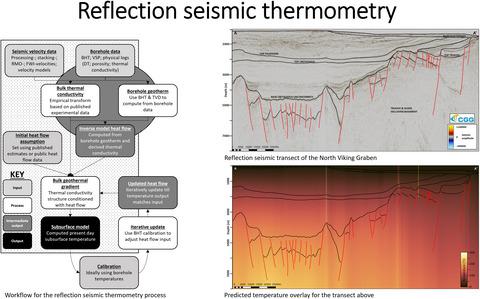当前位置:
X-MOL 学术
›
Basin Res.
›
论文详情
Our official English website, www.x-mol.net, welcomes your
feedback! (Note: you will need to create a separate account there.)
Reflection seismic thermometry
Basin Research ( IF 2.8 ) Pub Date : 2021-08-27 , DOI: 10.1111/bre.12608 Arka Dyuti Sarkar 1 , Mads Huuse 1
Basin Research ( IF 2.8 ) Pub Date : 2021-08-27 , DOI: 10.1111/bre.12608 Arka Dyuti Sarkar 1 , Mads Huuse 1
Affiliation

|
The North Viking Graben (NVG) is part of the mature North Sea Basin petroleum province and designated as a major carbon storage basin for NW Europe. It has been extensively drilled over five decades with an abundance of well and seismic data in the public domain. As such it serves as an excellent setting to demonstrate the efficacy of a reflection seismic data led approach to predicting subsurface temperatures using a state-of-the-art, full-waveform inversion velocity model covering the entire NVG. In a forward modelling approach, an empirical velocity to thermal conductivity transform is used in conjunction with predefined heatflow to predict subsurface temperature. The predefined heatflow parameters are set based on the range of values from previous studies in the area. Abundant well data with bottom hole temperature (BHT) records provide calibration of results. In the second step of inverse modelling, BHTs and the velocity derived thermal conductivity are used to derive heat flow based on a 1D steady-state approximation of Fourier's law. In this way, heatflow is estimated over the 12,000 km2 model area at a km scale (lateral) resolution, highlighting lateral variability in comparison with the traditional point-based heatflow data sets. This heatflow is used to condition a final iterative loop of forward modelling to produce a temperature model that is best representative of the subsurface temperature. Calibration against 139 exploration wells indicate that the predicted temperatures are on average 0.6℃ warmer than the recorded values. BHT for the recently completed Northern Lights carbon sequestration 31/5-7 (Eos) modelled to be 97℃, which is 6℃ below the recorded BHT. This highlights the applicability of this workflow not only towards enhancing petroleum systems modelling work but also for use in the energy transition and for fundamental scientific purposes.
中文翻译:

反射地震测温
北维京地堑 (NVG) 是成熟的北海盆地石油省的一部分,被指定为西北欧的主要碳储存盆地。它已经被广泛钻探了五个十年,在公共领域拥有丰富的井和地震数据。因此,它是一个很好的环境,可以证明反射地震数据引导方法的有效性,该方法使用覆盖整个 NVG 的最先进的全波形反演速度模型来预测地下温度。在正向建模方法中,经验速度到热导率的转换与预定义的热流结合使用来预测地下温度。预定义的热流参数是根据该地区先前研究的值范围设置的。具有井底温度 (BHT) 记录的丰富井数据提供了结果校准。在逆向建模的第二步中,基于傅里叶定律的一维稳态近似,使用 BHT 和速度导出的热导率来导出热流。这样,热流估计超过 12,000 公里2公里尺度(横向)分辨率的模型区域,与传统的基于点的热流数据集相比,突出了横向可变性。此热流用于调节正演建模的最终迭代循环,以生成最能代表地下温度的温度模型。对 139 口探井的校准表明,预测温度平均比记录值高 0.6℃。最近完成的北极光碳封存 31/5-7 (Eos) 的 BHT 模拟为 97℃,比记录的 BHT 低 6℃。这突出了该工作流程的适用性,不仅可以增强石油系统建模工作,还可以用于能源转型和基础科学目的。
更新日期:2021-08-27
中文翻译:

反射地震测温
北维京地堑 (NVG) 是成熟的北海盆地石油省的一部分,被指定为西北欧的主要碳储存盆地。它已经被广泛钻探了五个十年,在公共领域拥有丰富的井和地震数据。因此,它是一个很好的环境,可以证明反射地震数据引导方法的有效性,该方法使用覆盖整个 NVG 的最先进的全波形反演速度模型来预测地下温度。在正向建模方法中,经验速度到热导率的转换与预定义的热流结合使用来预测地下温度。预定义的热流参数是根据该地区先前研究的值范围设置的。具有井底温度 (BHT) 记录的丰富井数据提供了结果校准。在逆向建模的第二步中,基于傅里叶定律的一维稳态近似,使用 BHT 和速度导出的热导率来导出热流。这样,热流估计超过 12,000 公里2公里尺度(横向)分辨率的模型区域,与传统的基于点的热流数据集相比,突出了横向可变性。此热流用于调节正演建模的最终迭代循环,以生成最能代表地下温度的温度模型。对 139 口探井的校准表明,预测温度平均比记录值高 0.6℃。最近完成的北极光碳封存 31/5-7 (Eos) 的 BHT 模拟为 97℃,比记录的 BHT 低 6℃。这突出了该工作流程的适用性,不仅可以增强石油系统建模工作,还可以用于能源转型和基础科学目的。











































 京公网安备 11010802027423号
京公网安备 11010802027423号